Genealogists with ancestors in the British military have an enormous collection of records available to them in England and, in some cases, Canada. This is especially true if one knows the regiment that an ancestor was assigned to during their service. In this post we’ll be focusing on the British Army but the same principles apply to researching the Royal Navy, Royal Marines or the Royal Air Force.
If you know the regiment or regiments your ancestor served in then a good place to start is with the history of that unit. 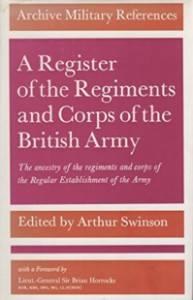 Many regiments now have websites – even those that have been inactive for a century or more. While our collection of military records and histories is concentrated on American units, especially Vermont organizations, we just acquired a history of British Army regiments entitled, Register of the Corps and Regiments of the British Army, by Arthur Swinson. This book covers almost all British regiments from the establishment of their professional army in the 1600’s to the 20th Century. Included are unit crests, motto’s, a list of campaigns and unit histories.
Many regiments now have websites – even those that have been inactive for a century or more. While our collection of military records and histories is concentrated on American units, especially Vermont organizations, we just acquired a history of British Army regiments entitled, Register of the Corps and Regiments of the British Army, by Arthur Swinson. This book covers almost all British regiments from the establishment of their professional army in the 1600’s to the 20th Century. Included are unit crests, motto’s, a list of campaigns and unit histories.
A second acquisition, In Search of the “Forlorn Hope”, by John M. Kitzmiller, II, is a two-volume “Comprehensive Guide to Locating British Regiments and Their Records.” The first 69 pages provide a brief history of the British Army, a definition of the terms used to describe various units and the differences between those units. It then covers how the organization of British fighting forces changed with the times and explains the various ranks of officers and enlisted men. A very useful section discusses how various record types are classified in the archives of the Public Records Office in London (at the Kew) and how to locate them both there and at the Family History Library in Salt Lake City. Finally, this section ends with advice on how to locate in which regiment an ancestor served and uses several case studies to explain how to address various research problems.
The next 1441 pages are devoted to listing the locations of all army units from 1640 to 1914 – just before the start of the First World War. Units are listed in chronological order by war or other action and within that by country. So one might find the 1st Royal Scots Regiment in 1694 at Namur, France in Volume 1 and locate them again in 1900 at Dewetsdorp, South Africa in Volume 2 (and at a hundred other places in between those dates).
I have an interest in the 44th Regiment of Foot (infantry) where one of my ancestors was serving as a young lieutenant during both the French and Indian War and the American Revolution. By searching in both ‘Canada’ and ‘North America’ I was able to locate his unit at the following times and places:
1755 Alexandria, VA / Ft. Cumberland, MD / Monongahela, PA
1756 Oneida Carry (Rome), NY / Hudson Valley, NY / Oswego, NY
1758 Ft. Duquesne, PA / Ft. Ticondergoa, NY / Lake George, NY /
1759 Crown Point, NY / Ft. Niagara, NY / Siege of Quebec City, QUE
1760 Isle Royale, NS / Siege of Montreal, QUE /
1762 Chambly, QUE
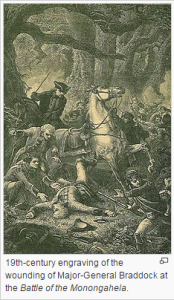 His unit was fighting with George Washington during Braddock’s Defeat at the Monogahela in 1755 – at that point one of the worst losses in the history of the British Army. It was involved in the subsequent campaigns against the French in New York, fought at the Siege of Louisbourg (1758), the Plains of Abraham (1759) and the final Siege of Montreal (1760)
His unit was fighting with George Washington during Braddock’s Defeat at the Monogahela in 1755 – at that point one of the worst losses in the history of the British Army. It was involved in the subsequent campaigns against the French in New York, fought at the Siege of Louisbourg (1758), the Plains of Abraham (1759) and the final Siege of Montreal (1760)
During the American Revolution it was located mainly in the northeast including Boston and Bunker Hill (1775), Long Island (1776), Brandywine Creek, PA (1777), Philadelphia, PA (1778) – the latter three battles against George Washington.
Obviously, one can learn quite a bit about the locations and battles of your British military ancestors from these two works. Did I mention that he was actually from Ireland? It is important to recognize that many Irishmen and Scotsmen fought in British units over several centuries.
With the information obtained from Kitzmiller a researcher can order microfilm from the FHL and have them sent to a Family History Center in Vermont, contact the PRO in London or use our subscription to FindMyPast.com to search online for Regimental Registers, Casualty Returns, Muster Books or Pension Returns.
These two books clearly open up a lot of exciting avenues for members with ancestors in the British Army.



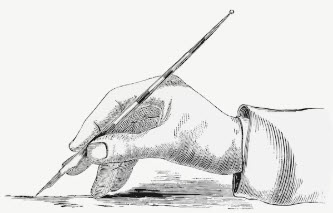
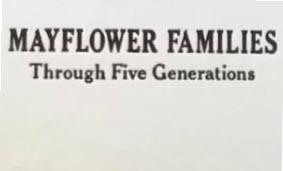
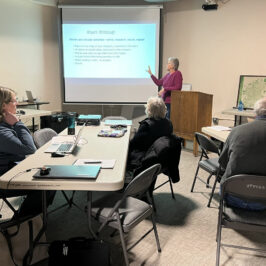

Leave a Reply